
GRADUATE UNIVERSITY OF SCIENCE AND TECHNOLOGY
VIETNAM ACADEMY OF SCIENCE AND TECHNOLOGY
NGUYEN THU ANH
Study of real-world semantics-based
interpretability of fuzzy system
Major: MATHEMATICAL BASIS FOR INFORMATICS
Code: 62.46.01.10
SUMMARY OF MATHEMATICS DOCTORAL THESIS
SCIENTIFIC INSTRUCTOR:
Ph.D. Tran Thai Son
Hanoi 2019

1
INTRODUCTION
In some areas, we expect machinery to be able to simulate behavior,
reasoning ability like human and give human reliable suggestions in the
decision-making process. A prominent feature of human is the ability to reason
on the basis of knowledge formed from life and expressed in natural language.
Because the language characteristic is fuzzy, the first problem that needs to be
solved is how to mathematically formalize the problems of linguistic semantic
and handle semantic language that human often uses in daily life.
In response to those requirements, in 1965, Lotfi A. Zadeh was the first
person to lay the foundation for fuzzy set theory. Based on fuzzy set theory,
Fuzzy Rule Based System (FRBS) has been developed and become one of the
tools of simulating reasoning method and making decisions of human in the
most closely manner. FRBS has been successfully applied in solving practical
problems such as control problem, classification problem, regression problem,
language extraction problem, etc...
When building FRBSs, we need to achieve two goals: accuracy and
interpretability. The thesis will focus on the study of interpretability.
In [1]1 Gacto finds that there are currently two main approaches to
interpretability. The first approach is based on complexity and the second
approach is based on semantics. Another approach proposed by Mencar et. al. in
[2]2, called similar measure function-based approach to assess the
interpretability of semantics-based fuzzy rules. The interpretability of fuzzy
rules is measured by the similarity between knowledge represented by fuzzy set
expression and linguistic expression in natural language.
In 2017, a new approach to the interpretability of fuzzy system is Real-
world-semantics-based approach – RWS-approach, has been first-time proposed
and initially surveyed in [3]3. This approach is based on real-world semantics of
words and relations between semantics of fuzzy system components and
corresponding component structures in the real world.
Derived from the recognition that fuzzy set expressions, especially fuzzy
rules of fuzzy systems have no relationship based on methodology with real
world semantics and, therefore, there are no formal basis to study the nature of
interpretability, his thesis chooses the real-world-semantics-based approach
proposed in [3] to study the interpretability of fuzzy systems.
1 M.J. Gacto, R. Alcalá, F. Herrera (2011), Interpretability of Linguistic Fuzzy Rule-Based
Systems: An Overview of Interpretability Measures. Inform. Sci., 181:20 pp. 4340–4360.
2 C. Mencar, C. Castiello, R. Cannone, A.M. Fanelli (2011), Interpretability assessment of fuzzy
knowledge bases: a cointension based approach, Int. J. Approx. Reason. 52 pp. 501–518.
3 Cat Ho Nguyen, Jose M. Alonso (2017), “Looking for a real-world-semantics-based approach to
the interpretability of fuzzy systems”. FUZZ-IEEE 2017 Technical Program Committee and
Technical Chairs, Italy, July 9-12.

2
At the same time, at present, methods of building FRBS from data in
fuzzy set theory-based approach lack a full formal link between fuzzy sets
representing the assumed semantics of a word and its inherent semantics. The
words used in FRBS are only considered as labels or symbols assigned to
corresponding fuzzy sets, are very difficult to fully convey underlying semantics
compared with natural linguistic words. Therefore, this thesis wishes to further
study the interpretability of linguistic fuzzy systems in the semantic approach
based on the hedge algebra proposed by Nguyen and Wechler [4]4 [5]5. In this
approach, the computational semantics of words shall be defined based on the
inherent order semantics of the words and word domains of the variables that
establish an order-based structure that are rich enough to solve the problems in
fact.
This thesis has achieved some following results:
Research and analysis of interpretability are as a study of the relationship
between RWS of linguistic expressions and computational semantics of
computational expressions assigned to linguistic expressions. The schema
proposal solves the problem of interpretability of the computational
representation of liguistic frame of cognitive (LFoC).
The study proposing constraints on interpretation operations is built to
convey, preserve the desired semantic aspects of the LFoC for fuzzy systems.
Application of HA approach solves the problem of interpretability of
computional representation of LFoC by establishing a granular polymorphism
structure of triangular fuzzy sets or trapezoidal fuzzy sets.
Further clarify RWS interpretation of human natural languages and word
domains of variables and its basic role in checking RWS interpretability of
components of fuzzy system, at the same time, prove that the standard fuzzy set
algebras are not RWS interpretability.
Propose formalization method to solve RWS interpretation of fuzzy
systems in the second case and n input variable.
CHAPTER I : BASIC KNOWLEDGE
1.1 Fuzzy set
Definition 1.1. [6]6 Let U be the universe of objects. The fuzzy set A on U is
the set of ordered pairs (x,
A(x)), with
A(x) being the function from U to [0,1]
4 C.H. Nguyen and W. Wechler (1990), “Hedge algebras: an algebraic approach to structures of sets
of linguistic domains of linguistic truth variables”, Fuzzy Sets and Systems, vol 35, no.3, pp. 281-
293.
5 Cat-Ho Nguyen and W. Wechler (1992),” Extended hedge algebras and their application to Fuzzy
logic”, Fuzzy Sets and Systems, 52, 259-281.
6 L. A. Zadeh, Fuzzy set, Information and control, 8, (1965), pp. 338-353

3
assigned to each element x of U value
A(x) reflects the degree of x belong to
fuzzy set A.
If
A(x) = 0, then we say x does not belong to A, otherwise if
A(x) = 1, then
we say x belongs to A. In Definition 1.1, function
is also called is a
membership function.
1.2 Linguistic variable
Simply as said by Zadeh, a linguistic variable is a variable in which "its
values are words or sentences in natural language or artificial language".
1.3 Fuzzy rule based system
1.3.1. The components of the fuzzy system
A fuzzy rule based system consists of the following main components:
Database, Fuzzy Rule-based - FRB and Inference System.
- Database is sets of 𝔏j including linguistic label Tj corresponding to fuzzy
sets used to reference domain fuzzy partition UjR (real number set) of variable
𝔛j, (j=1,..,n+1) of problem n input 1 output.
- Fuzzy rule base is a set of fuzzy rules if-then.
- Reasoning system performs an approximate reasoning based on rules and
input values to produce the predicted output value. Some approximate reasoning
directions are as follows:
+ Approximate reasoning based on fuzzy relationship
+ Approximate reasoning by linear interpolation on fuzzy set
+ Reasoning based on the rule burning
1.3.2. Objectives upon building FRBS
Evaluation of the effectiveness (accuracy) of FRBS
For the objective of the effectiveness of FRBS, we have mathematical
formulas to evaluate how an FRBS is effective.
Problem of interpretability of FRBS
Interpretability is a complex and abstract problem, it involves many factors.
In [1] Gacto finds that there are currently two main approaches to the
interpretability:
- Interpretability is based on complexity:
Rule basis level: The less the number of rules of the rule system is, the
shorter the length of the rule is.
Fuzzy partition level: number of attributes or number of variables,
number of variables used less will increase the interpretability of the rule
system. The number of functions is used in the fuzzy partition, the number of
functions should not be exceeded 7±2 [6].
- Interpretability is based on semantics:
Semantics at the rule basis level: The rule basis must be consistent, ie. it
does not contain contradictory rules, the rules with the same premise must have

4
the same conclusion, the number of rules burned by an input data is as little as
possible.
Semantics at fuzzy partition level (word level): The defined domain of
variables must be completely covered by the function of fuzzy sets.
1.4 Hedge algebra
1.4.1. The concept of hedge algebra
Definition 1.2 [7]7: A hedge algebra is denoted as a set of 4 components
denoted by AX = (X, G, H, ) where G is a set of generator, H is a set of hedges,
and “” is a partial ordering relation on X. The assumption in G contains
constants 0, 1, W with the meaning of the smallest element, the largest element
and the neutral element in X. We call each language value xX a term in HA.
If X and H be linearly ordered sets, then AX = (X, G, H, ) is sais a linear
hedge algebra. And if two critical hedges are fitted and with semantics being
the right upper bound and right lower bound of the set H(x) when acting on x,
then we get the complete linear HA, denoted by AX* = (X, G, H, , , ). Note
that hn...h1u is called a canonical representation of a term x for u if x = hn...h1u
and hi...h1uhi-1...h1u for i is integer and in. We call the length of a term x is the
number of hedges in its canonical representation for the generated element plus
1, denoted by l(x).
1.4.2. Some properties of linear hedge algebra
Theorem 1.1: [7] Let the sets H- và H+ of a hedge algebra AX = (X, G, H,
) be linearly ordered. Then, the following statements hold:
i) For every uX, H(u) is a linearly ordered set.
ii) If X is a primarily generated hedge algebra and the set G of the primary
generators of X is linearly ordered, then so is the set H(G). Furthermore, if u<v,
and u, v are independent, i.e. uH(v) và vH(u), thì H(u) H(v).
The theorem below looks at the comparison of two terms in the linguistic
domain of variable X
Theorem 1.2: [7] Let x = hn…h1u and y = km…k1u be two arbitrary
canonical representations of x and y w.r.t. u. Then there exists an index j ≤
min{n, m} + 1 such that hj' = kj' for all j'<j (here if j = min {n, m} + 1 then either
hj = I, hj is the unit operator I, for j = n + 1 ≤ m or kj = I for j = m + 1 ≤ n) and
i) x<y iff hjxj<kjxj, where xj = hj-1...h1u.
ii) x = y iff m = n and hjxj = kjxj.
iii) x and y are not comparable iff hjxj and kjxj are not comparable.
7 C. H. Nguyen and V. L. Nguyen (2007), Fuzziness measure on complete hedges algebras and
quantifying semantics of terms in linear hedge algebras, Fuzzy Sets and Syst., vol.158 pp.452-471.


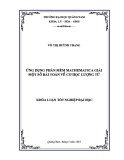
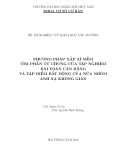

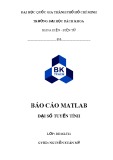

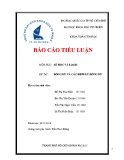
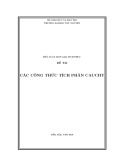
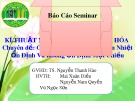
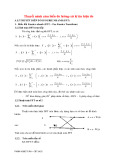

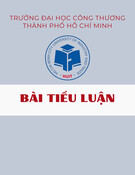
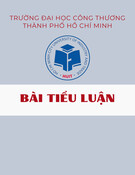
![Ô nhiễm môi trường không khí: Bài tiểu luận [Nổi bật/Chi tiết/Phân tích]](https://cdn.tailieu.vn/images/document/thumbnail/2025/20251011/kimphuong1001/135x160/76241760173495.jpg)







![Ứng dụng kỹ thuật trao đổi ion trong điện phân: Bài tiểu luận [chuẩn nhất]](https://cdn.tailieu.vn/images/document/thumbnail/2025/20250829/sonphamxuan1808/135x160/97341756442892.jpg)



